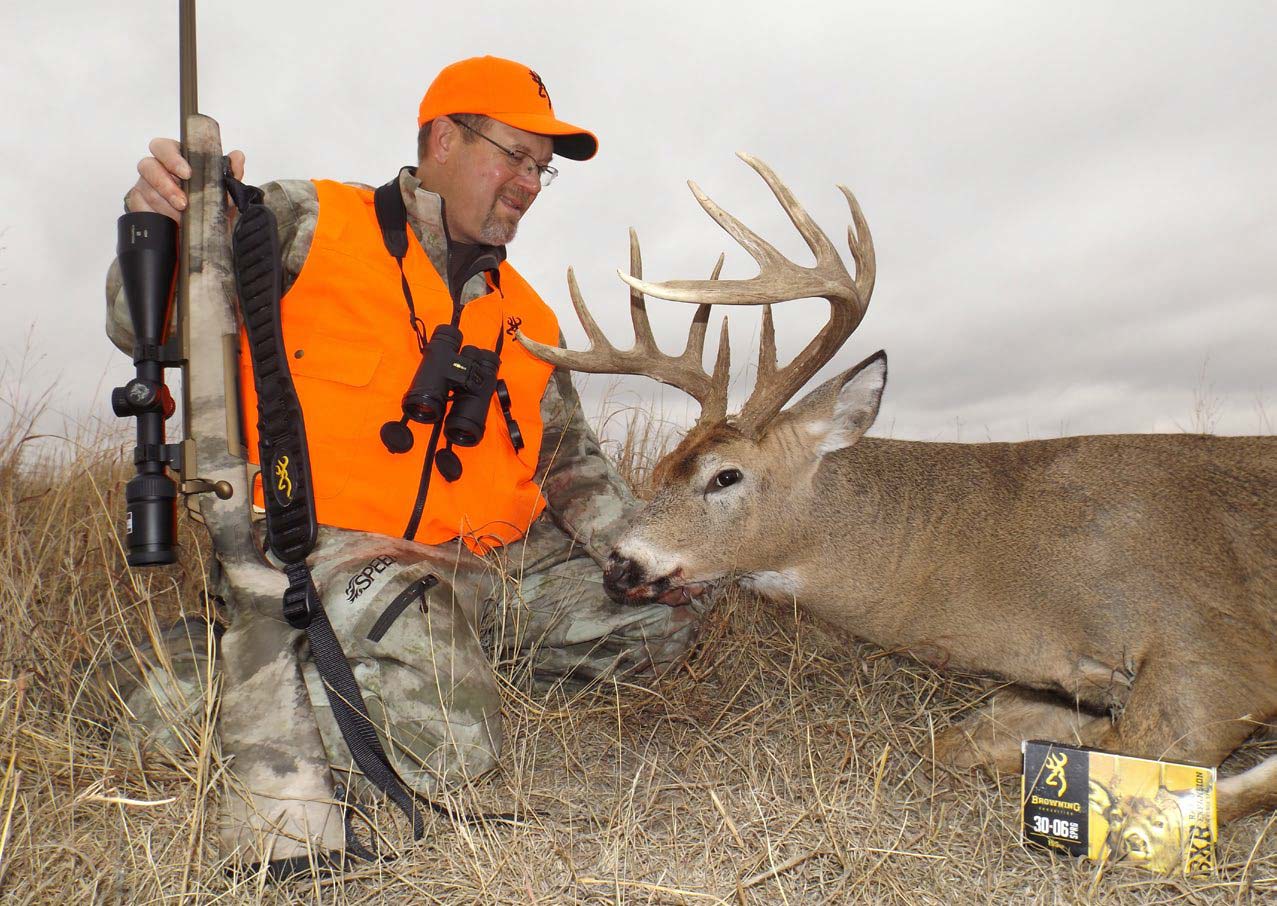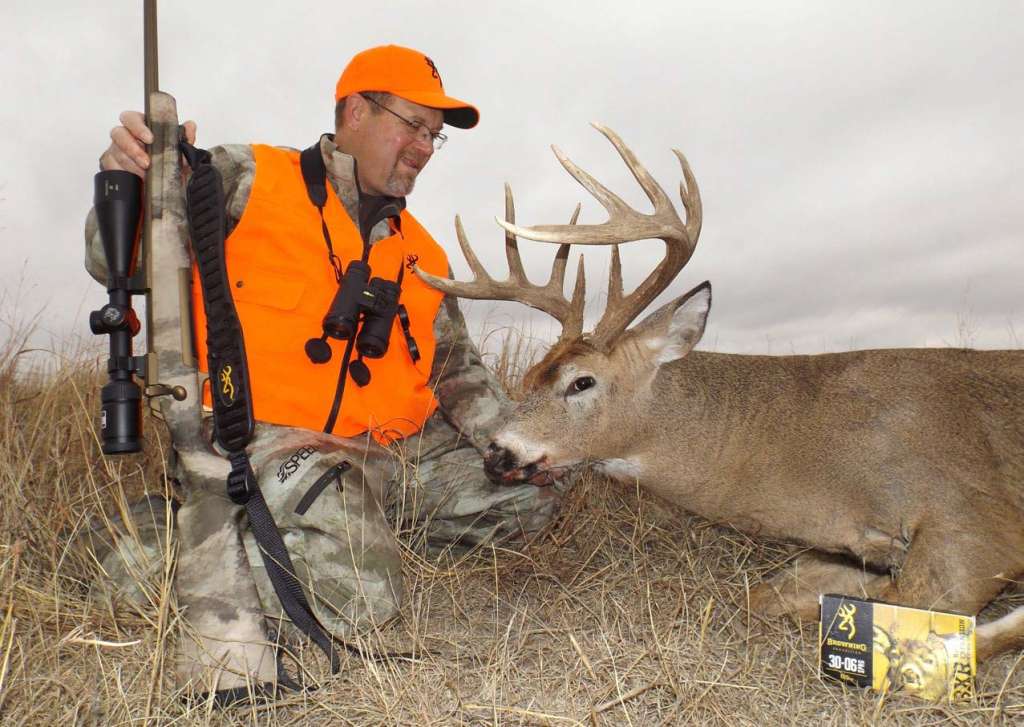
My phone started quacking indicating I had an incoming text. It was from our outfitter Scott Fink, of Goose Creek Outfitters in Nebraska, and he was sending trail camera photographs of deer showing up near some of his stand locations. At first, I couldn’t believe my eyes and enlarged the image to see if it had been photoshopped. There were two mature bucks standing beside each other but facing in opposite directions. One was a solid 160-class whitetail with ten even points while the other was an honest 170-class mule buck with four long points on each antler. The phone got passed around the truck spawning debate and discussion over what buck to shoot if given the opportunity.
I studied the photo long and hard and decided that I’d have to take the whitetail if blessed with the ultimate “First World Problem” of a deer hunter. Perhaps the fact I’ve taken several good mule deer influenced my decision, but ultimately it would be difficult for me to not shoot a whitetail of this caliber.
The first morning produced several sightings of good bucks while does wandering in and out of the Sandhills and small woodlot I was watching, but I just couldn’t get that big buck I had seen in the darkness out of my mind. And, I couldn’t help but think the buck was the one in the photo standing beside the big mule deer. I asked Scott if it was possible and he confirmed the photo was taken about a mile from where we saw the deer. That was it; I was sitting the elevated stand overlooking the same meandering, brush-choked creek bed where I saw the buck head in the dark.
I had been in the stand less than an hour that afternoon when a herd of mule deer fed into the pasture on the other side of the creek. There were three bucks in the group, including a big four-by-four who also looked suspiciously familiar. Looking the deer over carefully with my Nikon binoculars left little doubt it was the mule deer in the photo. How could it even be possible that I saw the same two bucks on my first day of hunting? To make matters worse, the big muley wandered well within range, and I was now faced with the dilemma we all talked about—I just couldn’t bring myself to shoot the buck. I had told everyone I would want the whitetail, and that is what I was holding out for.
Just after 3:00 p.m. I spotted movement on a distant creek edge at the far end of the field. I lifted my binoculars and could make out the five distinct points on each antler at over 500 yards. It was the buck I was after, but he was on a mission and headed straight south.
I knew there was potential for long shots in the open country and after sighting in my new Browning X-Bolt Hell’s Canyon Speed bolt-action rifle in .30-06, and shooting a near perfect cloverleaf, I was up for the task. However, 500 yards on a moving target just isn’t an option in my books. I knew we had several days to hunt and planned to stay glued to my stand to get another look at the big buck.
The next morning I was back in the same blind well before sunrise. The mule deer were out in the pasture with the herd buck just 262 yards away. I could see whitetail does in front of me with more trickling out of the Sandhills behind the blind. Watching the sun break the horizon I spotted my whitetail buck running towards the creek chasing a doe. I quickly ranged them at 360 yards before they ran into the creek bottom across from me.
“I watched through my scope and as the buck came up on a rise he stopped to look back before heading out of the creek. I squeezed the trigger.”
The old channels and oxbows carved over centuries into the prairie landscape made it next to impossible to see the deer. They popped in and out of sight as the buck chased the doe relentlessly.
I couldn’t take my eyes off the cover and occasionally caught glimpses of antler or glistening hide in the sun. Scott came to pick me up near noon, and I waved him on, as there was no way I was leaving my blind when I knew the buck was still in the creek.
I developed a routine where I’d scan with my binoculars for a minute then watch with the naked eye for a minute. It was an intense day of glassing but proved worthwhile as I continued to locate the deer in different areas. Sometimes I’d see antlers with the binoculars and other times I’d see the shiny hair moving in the cover with the naked eye. The pair eventually bedded down, and activity ground to a halt. I sat for hours hoping to see the deer again.
When I caught movement again, it was three does, and I had no idea where they come from. It also made me worry my buck had somehow snuck out a back door. However, the movement in the cover kicked my deer out of their beds, and the chase was on once again.
I tracked them back and forth through the cover for an hour before I saw the doe run down the far edge of the creek and knew it was a breeding chase. I steadied my rifle for the shot, but nothing appeared. With the sun setting fast, so where my hopes of seeing the deer before dark. Then, I caught movement and saw the buck traveling solo through an old creek channel. He’d bred the doe after courting her all day and was off to find the next. I watched through my scope and as the buck came up on a rise he stopped to look back before heading out of the creek. I squeezed the trigger.
The buck disappeared at the report of the rifle, and I watched frantically to catch any sign of movement.
Darkness descended faster than anticipated, and I barely had time to get to the area and mark the trees where the buck was standing when the headlights of Scott’s truck came over the hill. I nervously told him I had shot the buck but couldn’t find him before the light faded.
We got headlamps and went to the area where the deer last stood and wandered to the east and within seconds, Scott stumbled upon the deer. I had resolved the ultimate “First World Problem” and taken a grand old whitetail, even though the mule deer temptations teased me several times.
I sure hope I have similar problems again this year.
Browning BXR Rapid Expansion Deer Cartridges
Many hunters don’t understand the premise of a good deer cartridge and bullet. Large wound channels and big exit holes mean easy to follow blood trails and reduced chance a deer will leave the property you’re hunting. The BXR rapid expansion bullet has a matrix tip designed specifically for all kinds of deer hunting. The tip allows for high downrange velocities and energy retention while being the catalyst for rapid expansion on impact. The tip breaks apart as it drives back into the bullet to maximize expansion. The massive expansion means quick knockdown power, so deer go nowhere after the shot, or there is a trail to ensure you’ll find your deer. The new premium deer ammunition by Browning worked exceptionally and was the reason my Nebraska buck went under 20 yards from where he was standing when I shot him. At 172 yards the bullet passed through the deer and, although it left a big hole in his ribs, the deer was down within seconds. browningammo.com
By Brad Fenson

